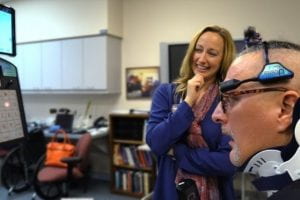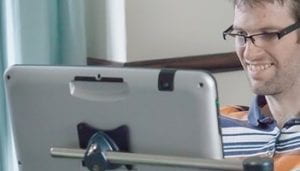 In a recent podcast for Speech Uncensored, Dr. Susan Fager discussed her research on access and communication technology, and how the work she is completing translates to clinical practice. Susan also covered the progression from low tech to high tech AAC that a patient may experience across their recovery stages. Dr. Fager provided case studies to illustrate creative problem solving and overcoming obstacles to provide patients with a means to express themselves.
In a recent podcast for Speech Uncensored, Dr. Susan Fager discussed her research on access and communication technology, and how the work she is completing translates to clinical practice. Susan also covered the progression from low tech to high tech AAC that a patient may experience across their recovery stages. Dr. Fager provided case studies to illustrate creative problem solving and overcoming obstacles to provide patients with a means to express themselves.
Supporting Communication of Individuals with Minimal Movement
- Transcript of presentation (pdf)
- Transcript of presentation (txt)
- Powerpoint slides as a handout (pdf)
This webcast was produced as part of the work of the AAC-RERC under grant #H133E080011 from the National Institute on Disability and Rehabilitation Research (NIDRR)in the U.S. Department of Education’s Office of Special Education and Rehabilitative Services (OSERS)
Communication support for People with ALS
 Beukelman, D., Fager, S., & Nordness, A. (2011). Communication support for people with ALS. Neurology Research International, 2011.
Beukelman, D., Fager, S., & Nordness, A. (2011). Communication support for people with ALS. Neurology Research International, 2011.
http://dx.doi.org/10.1155/2011/714693
Almost all people with amyotrophic lateral sclerosis (ALS) experience a motor speech disorder, such as dysarthria, as the disease progresses. At some point, 80 to of people with ALS are unable to meet their daily communication needs using natural speech. Unfortunately, once intelligibility begins to decrease, speech performance often deteriorates so rapidly that there is little time to implement an appropriate augmentative and alternative communication (AAC) intervention; therefore, appropriate timing of referral for AAC assessment and intervention continues to be a most important clinical decision-making issue. AAC acceptance and use have increased considerably during the past decade. Many people use AAC until within a few weeks of their deaths.
Adaptive Access: Key Design Considerations
Dr. Susan Fager (University of Nebraska at Lincoln) and Dr. Adaptive Access: Key Design ConsiderationsJeff Higginbotham (State University of New York at Buffalo) present on Key Design Considerations for People with Communication, Motor, and Cognitive Challenges at the AAC-RERC State of the Science Conference in Baltimore Maryland, June 28, 2012.
This webcast was produced as part of the work of the AAC-RERC under grant #H133E080011 from the National Institute on Disability and Rehabilitation Research (NIDRR)in the U.S. Department of Education’s Office of Special Education and Rehabilitative Services (OSERS)